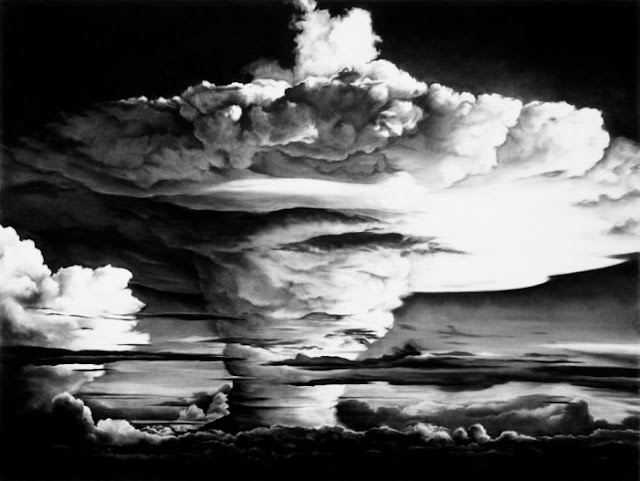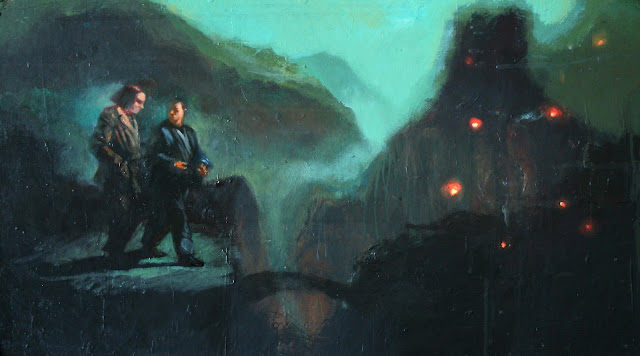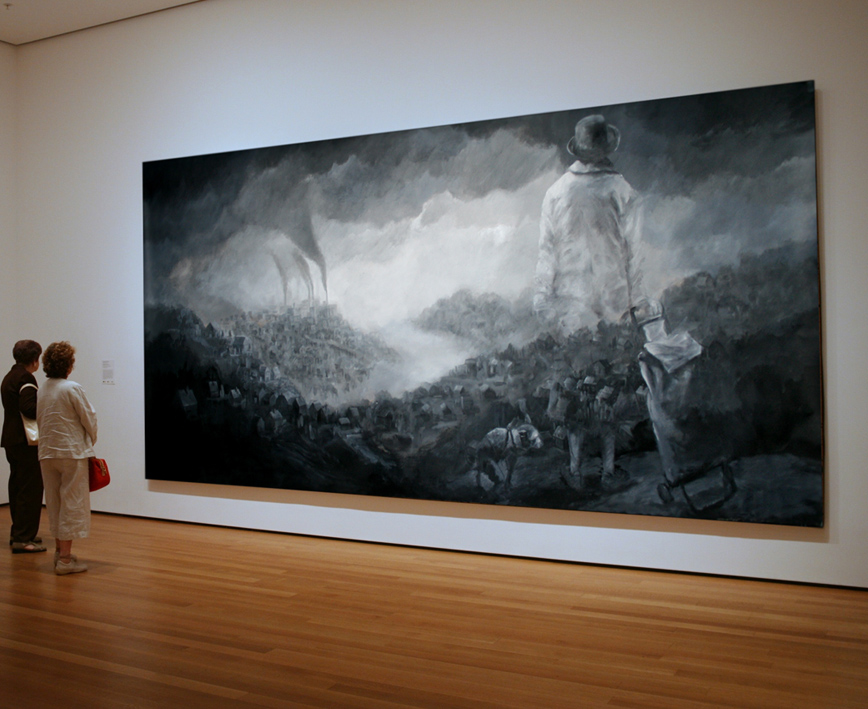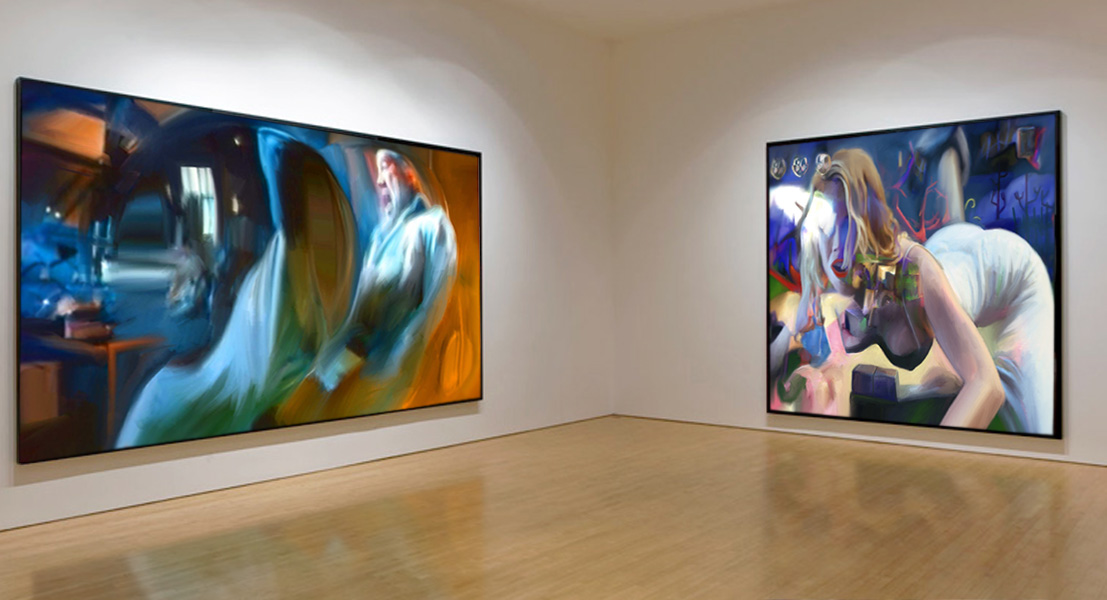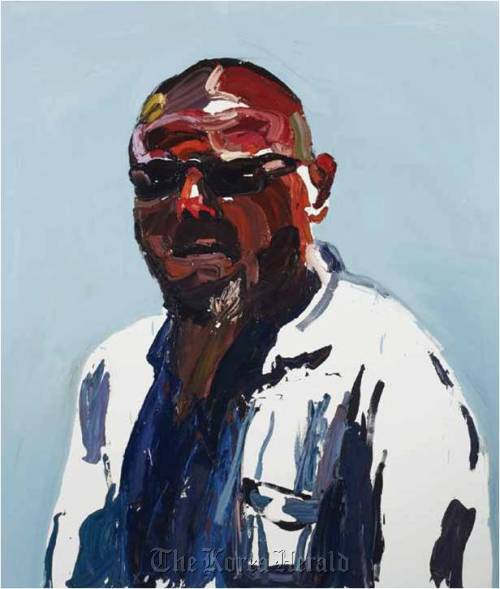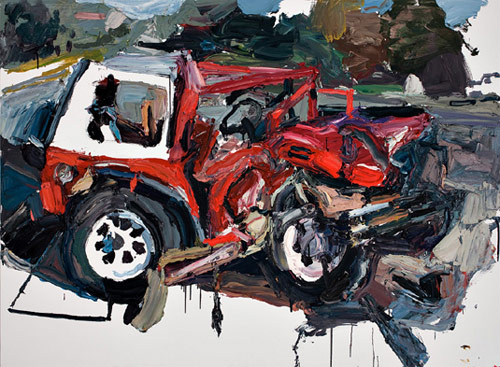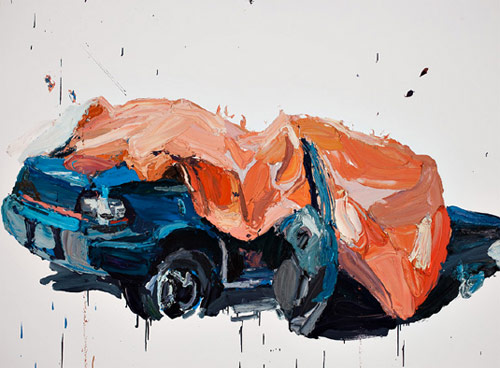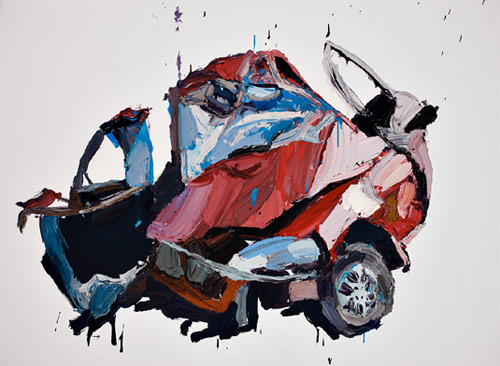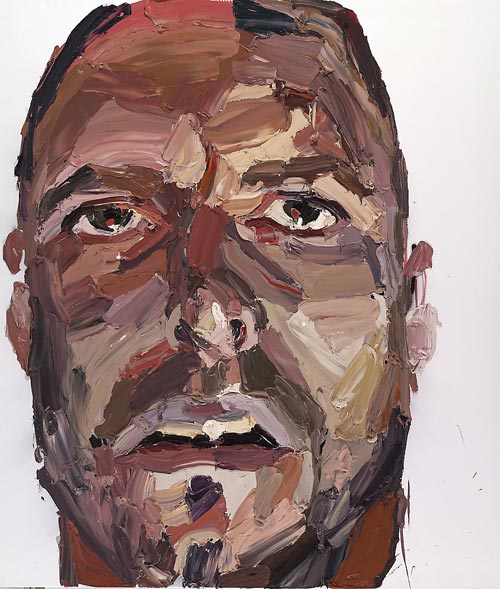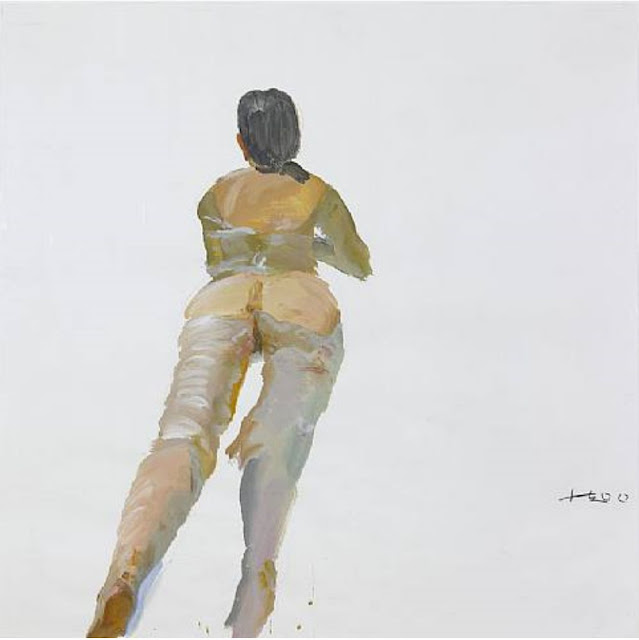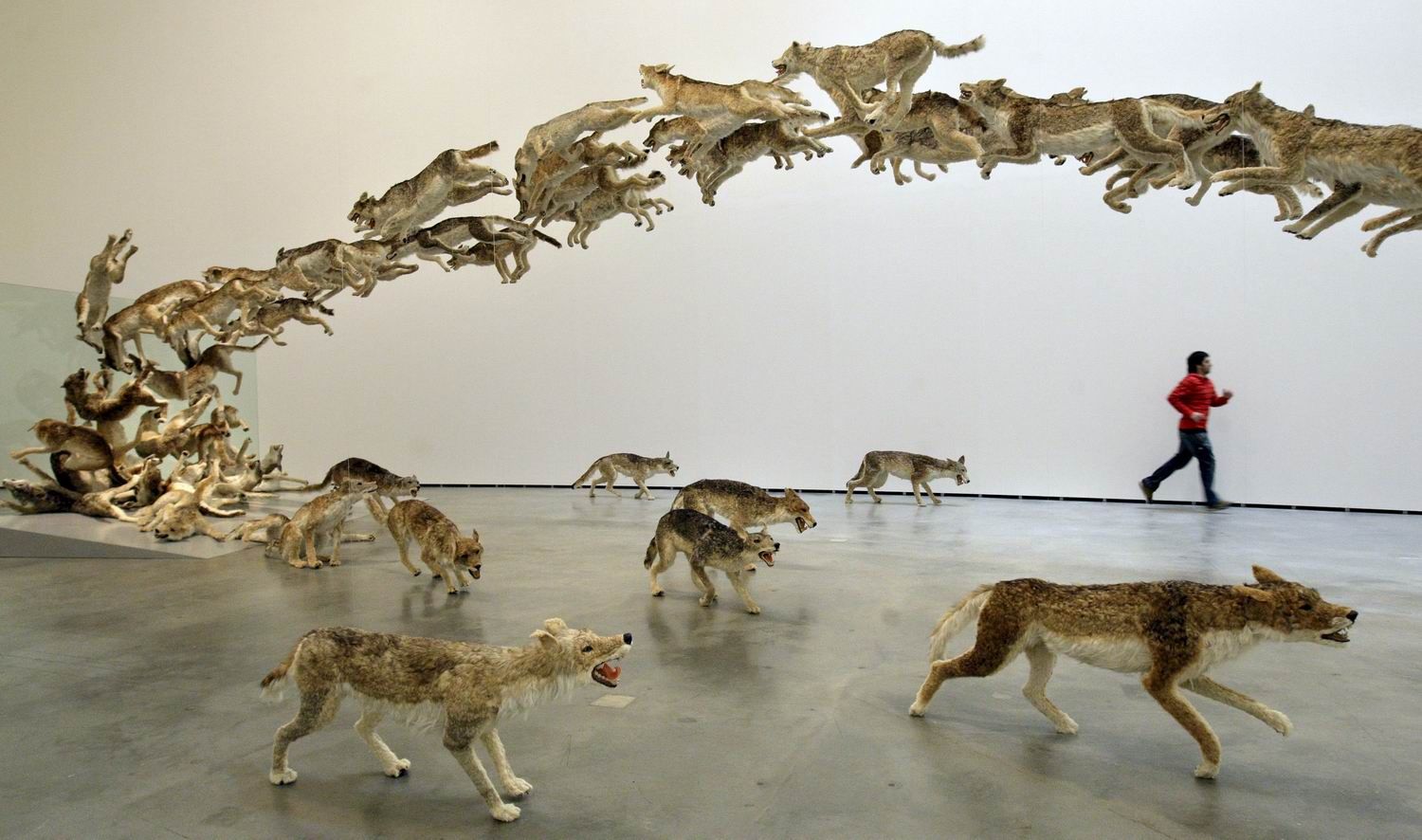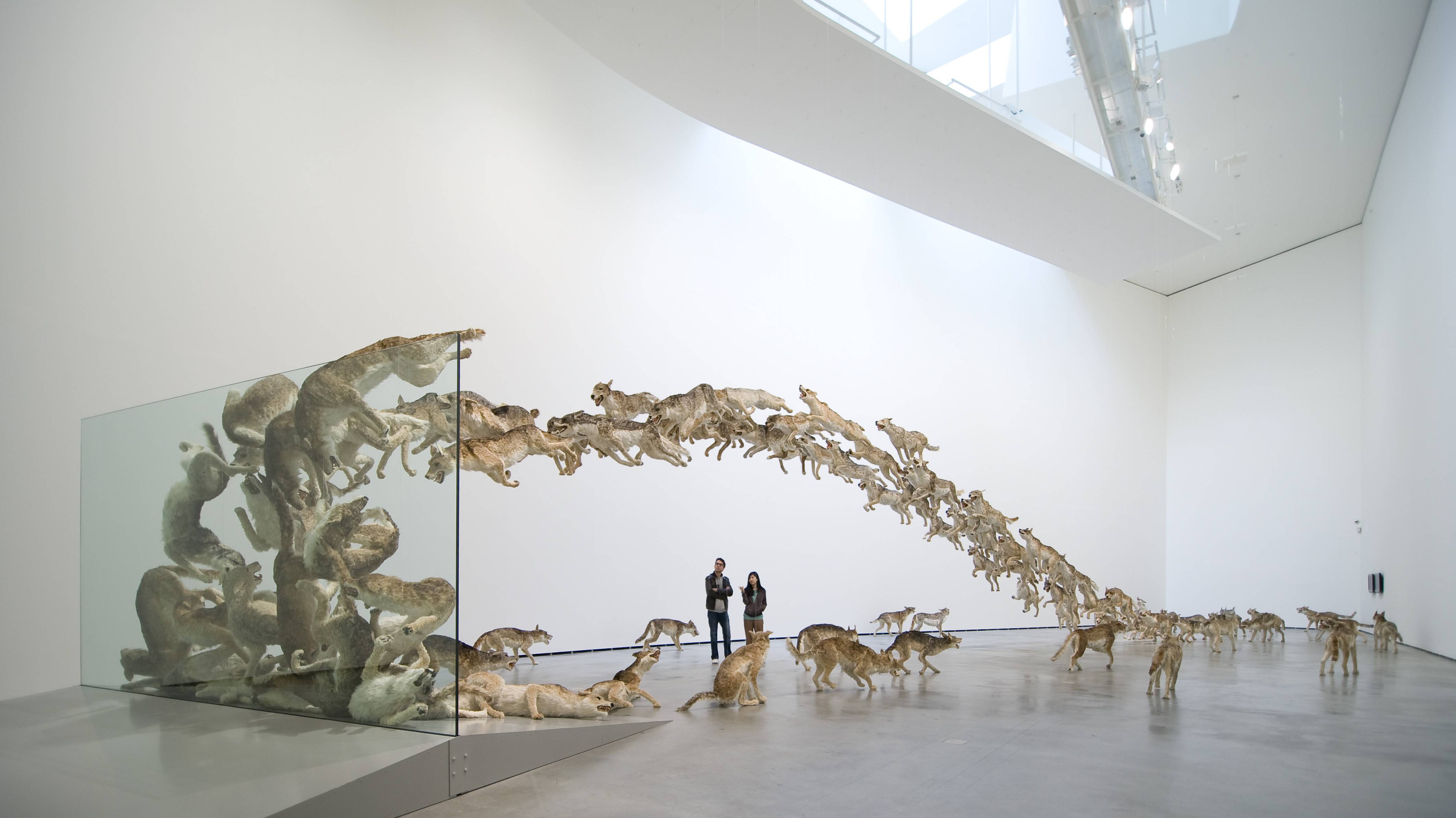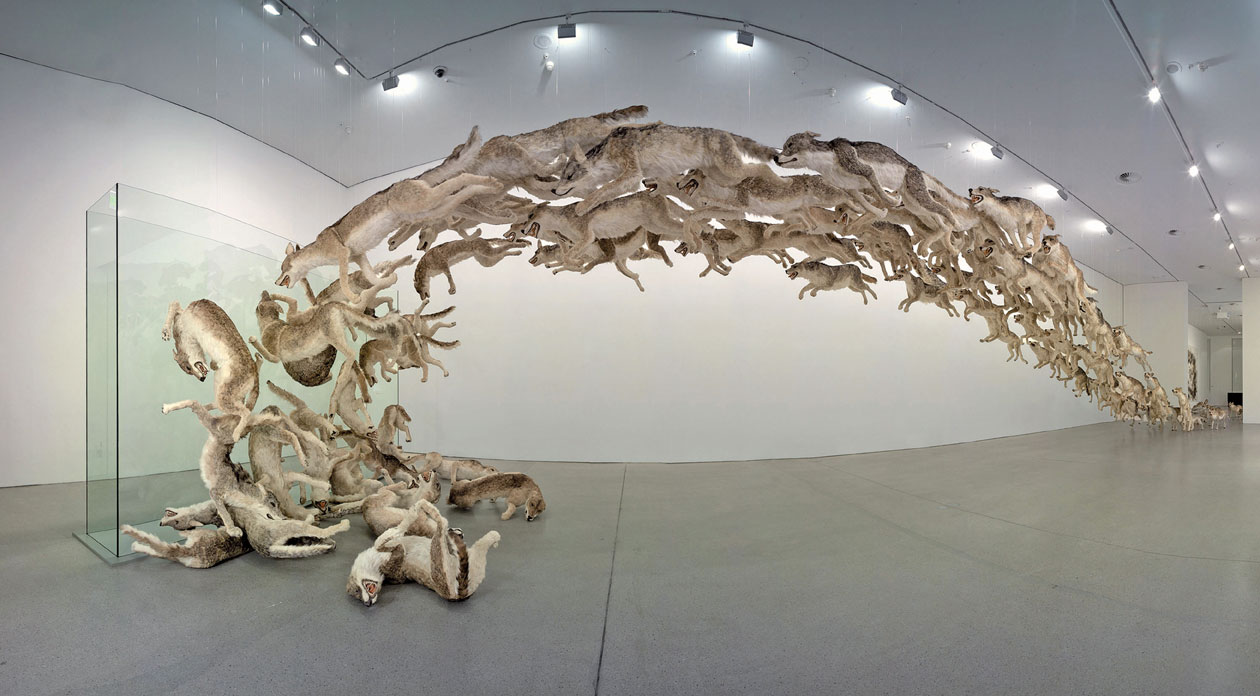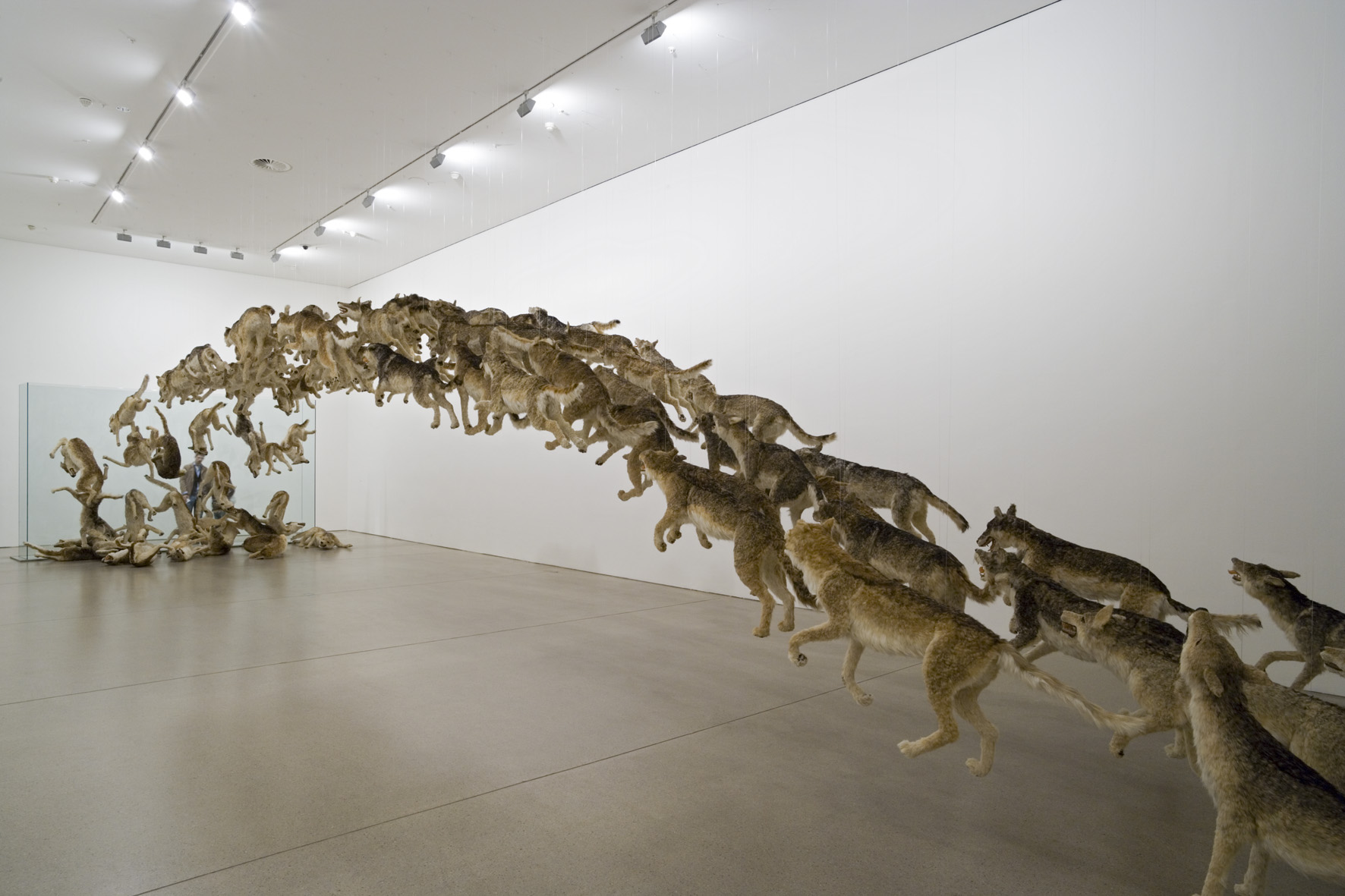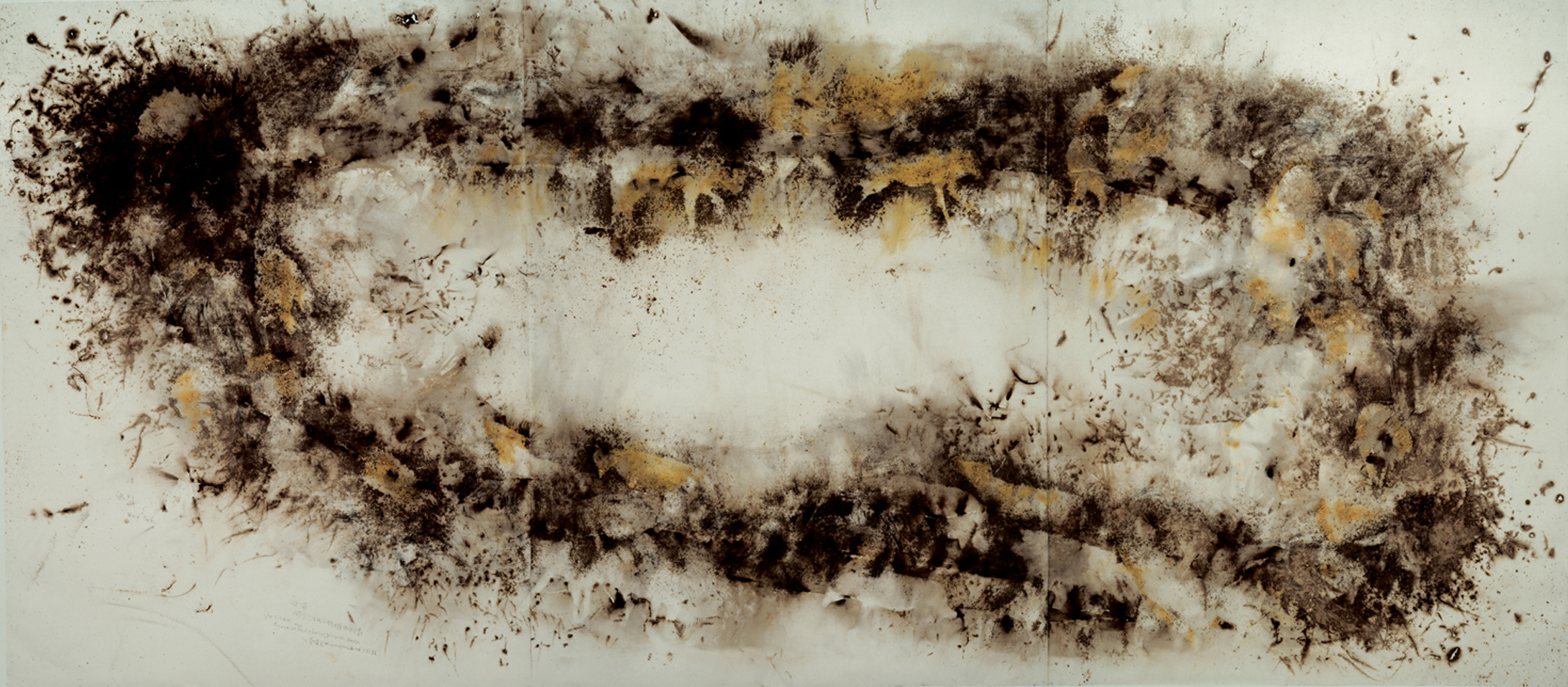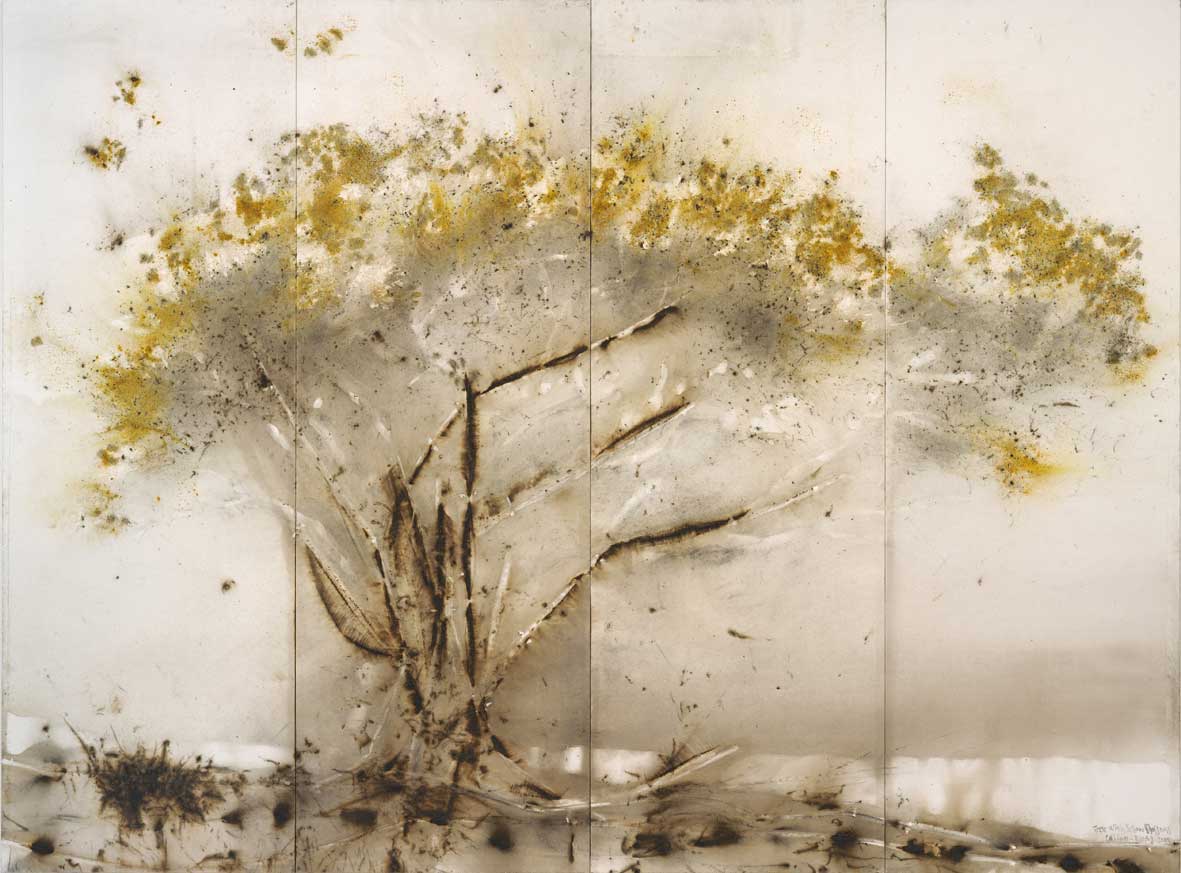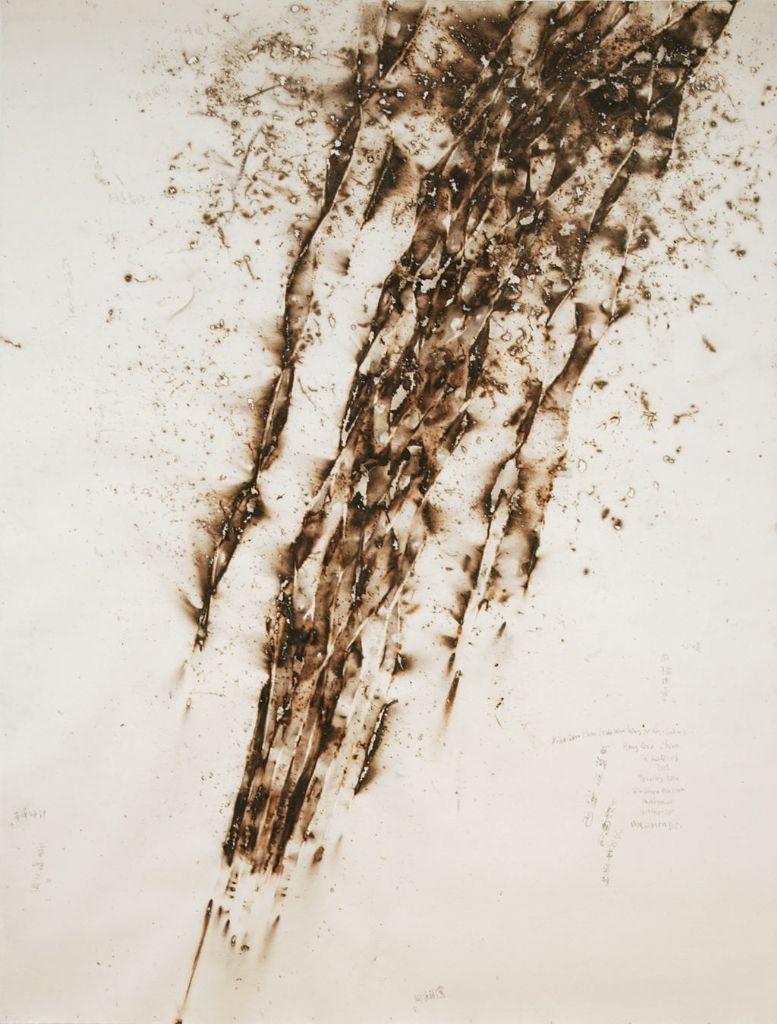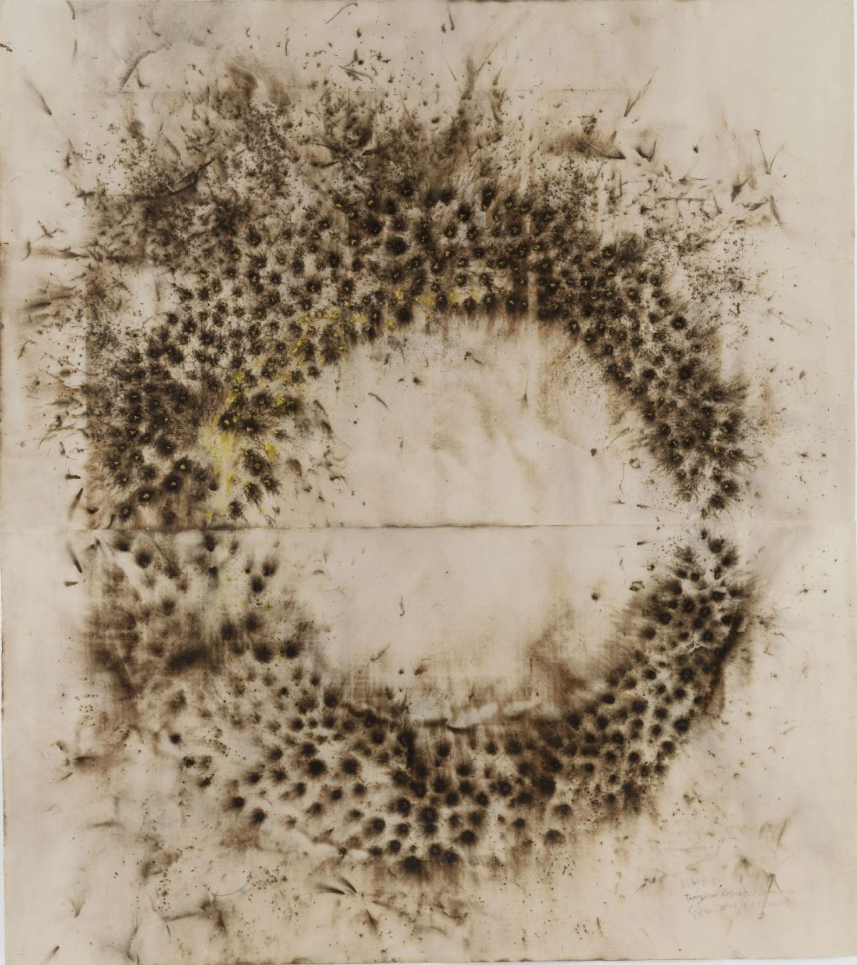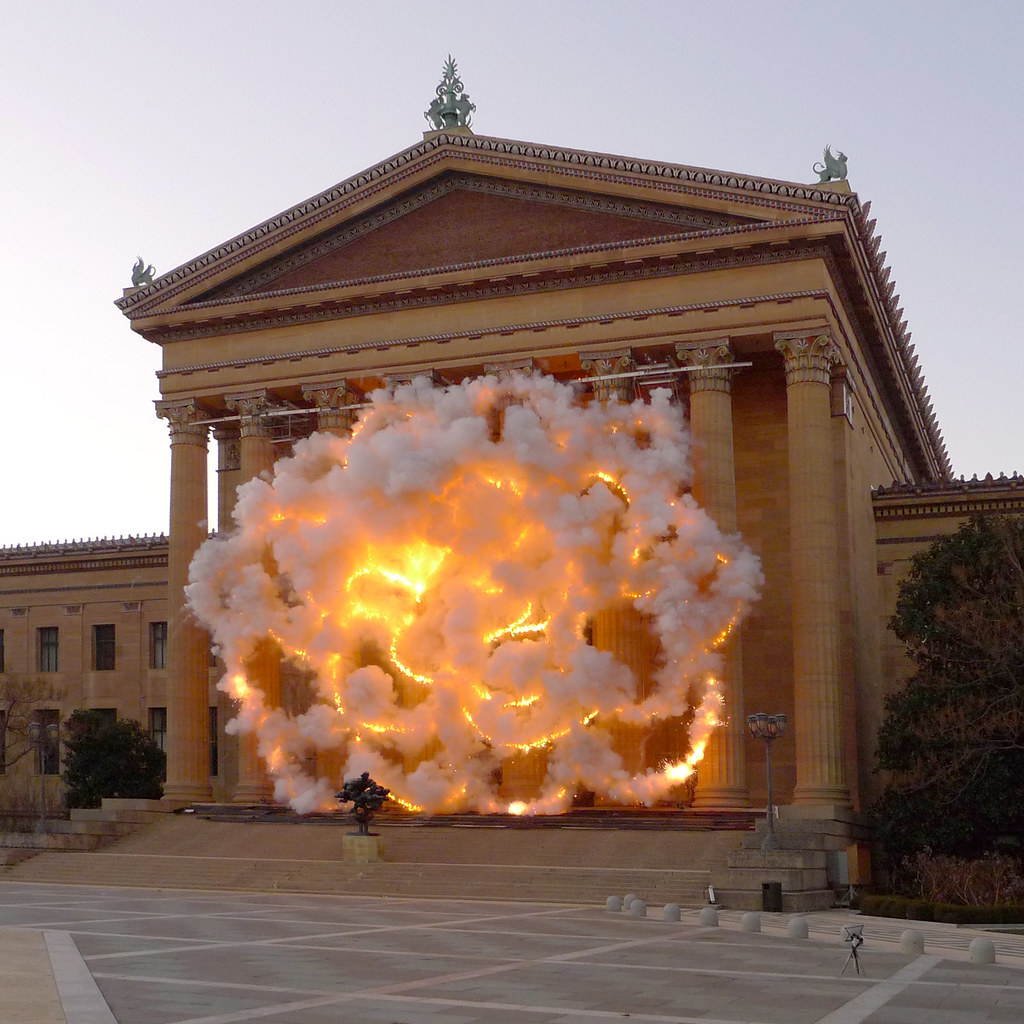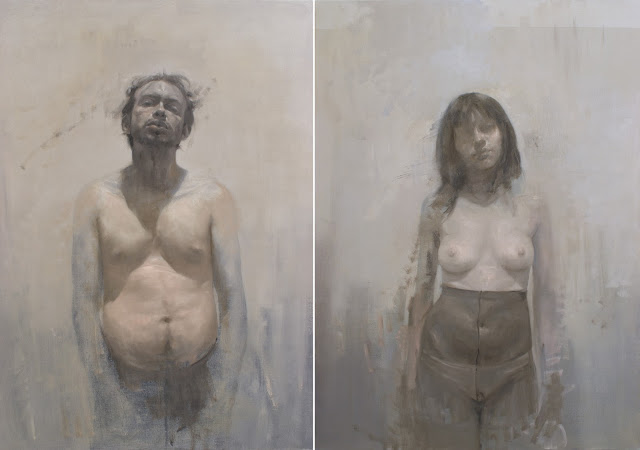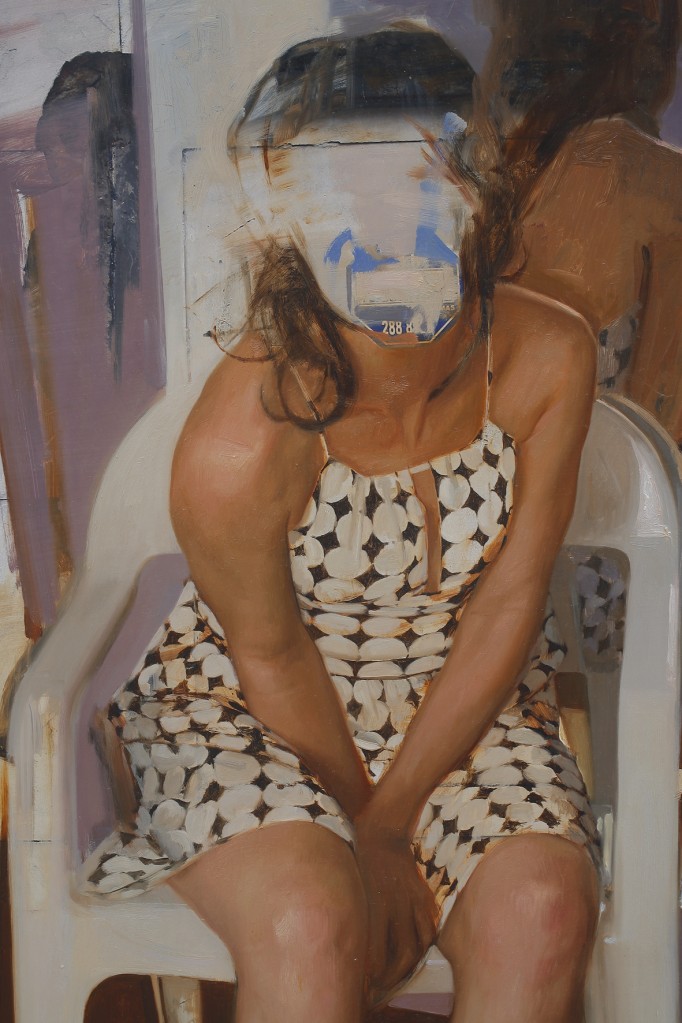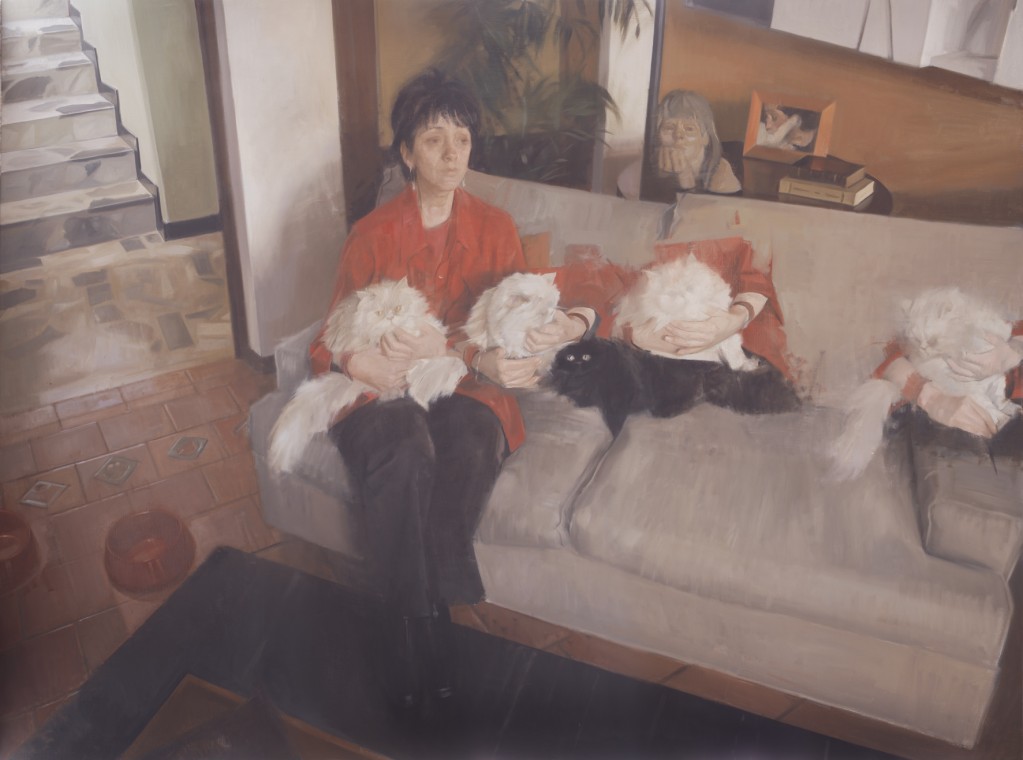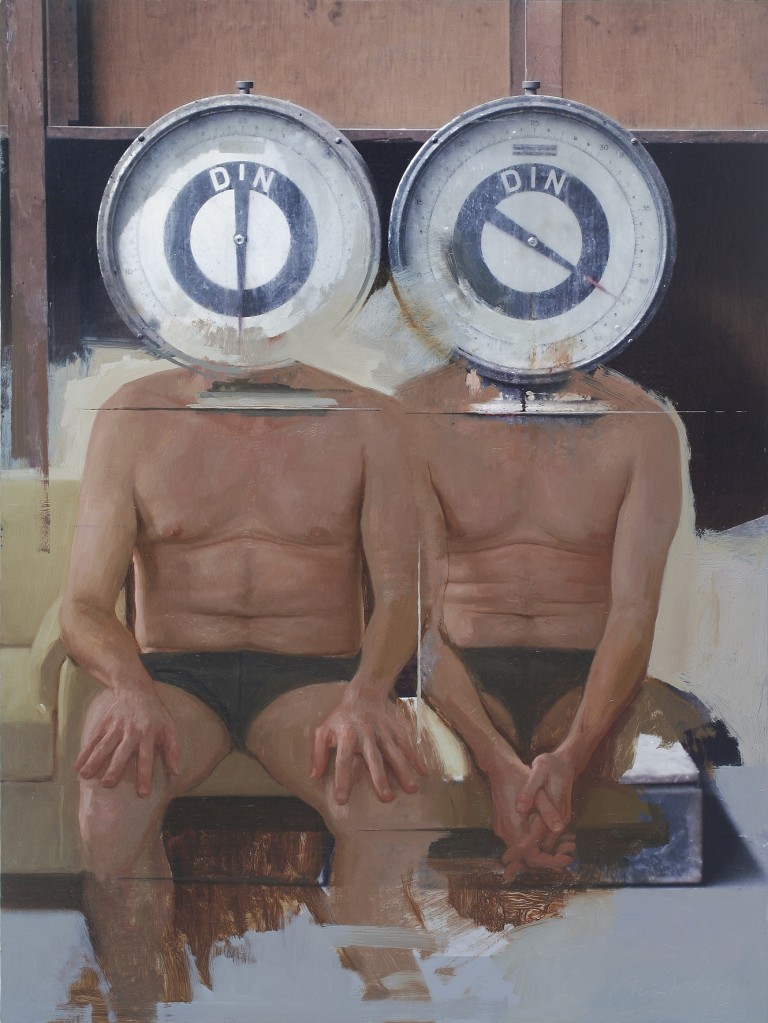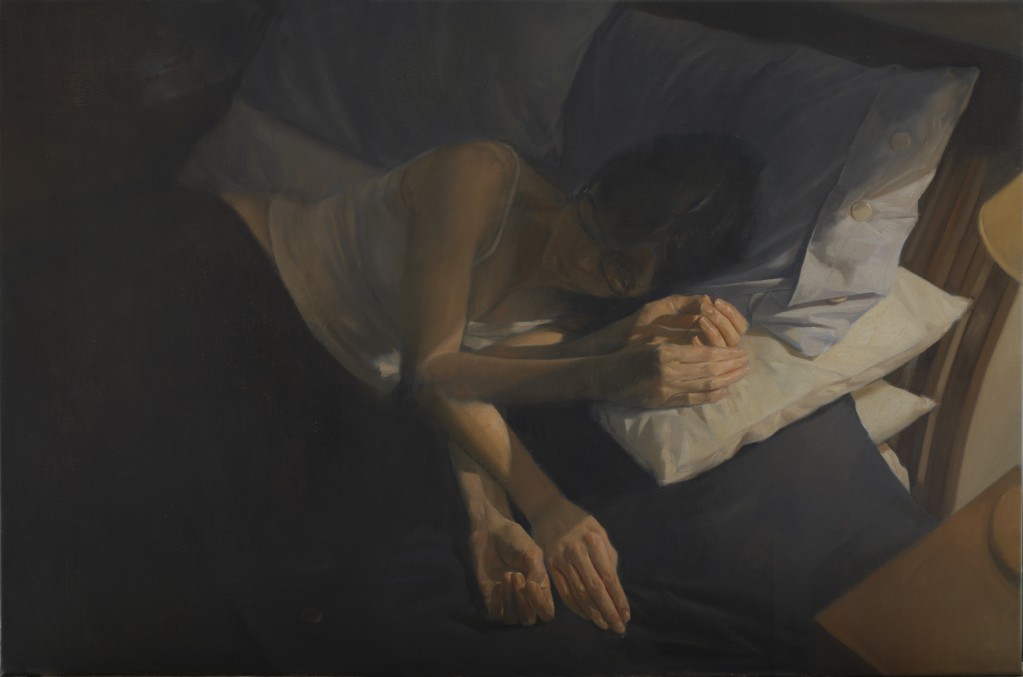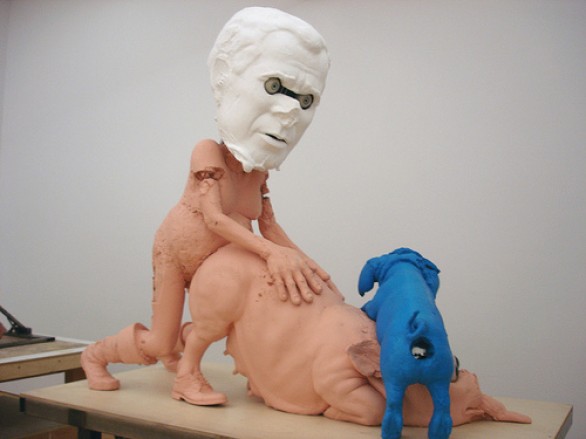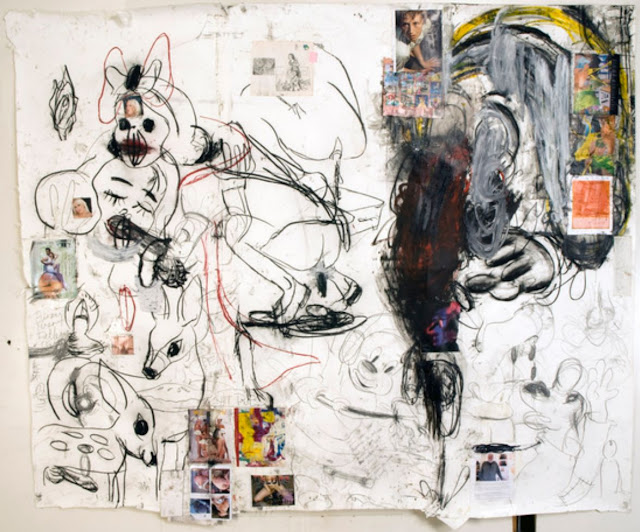Paul McCarthy
Paul McCarthy - born in 1945 in Salt Lake City, centre of the Mormons - studied at the University of Utah (1969), painting at the San Francisco Art Institute, and film, video, and arts at the University of Southern California (1972). From 1982 onwards, he teaches performance, video, installation, and the history of performance art at the University of California, where, as it appears, he influenced other great artists like Jason Rhoades, Cindy Sherman, Mike Kelley, Jonathan Meese, John Bock, Jake and Dinos Chapman. As an artist, he remains relatively unknown. But since the exhibition of 'The Garden' in the Museum of Contemporary Art in Los Angeles in 1992, his star is rising. In 2001, there is a retrospective in the New Museum of Contemporary Art in New York, the Villa Arson in Nice, and in Tate Liverpool. Soon, extensive surveys of his work are presented in the Van Abbemuseum in Eindhoven (2004), the Haus der Kunst te München (2005), the Moderna Museet in Stockholm (2006), the ARoS Aarhus Kunstmuseum in Denemark (2006) and the S.M.A.K in Gent (2006-2007). And, during the summer of 2007, the Middelheim in Antwerp organised 'Air Borne - Air Borne'', an exhibition of the recent large scale inflatable sculptures.
Let us have a closer look at the works of this artist - who was until recently completely unknown, but turns out to be a 'living legend', yes even to belong to the 'most important and influential artists of his generation.
HAPPENING, AKTION, PERFORMANCE
In 1967, Paul McCarthy joins the trend of the happening, introduced in 1959 by Allen Kaprow, with works like 'Sudden Leap' (1967), in which he jumps out of a window, 'Black Paintings' (1967-1968), in which he chars canvases with a blow torch, 'Face painting - Floor white line' (1972), in which he paints a line with his own face, and 'Plaster Your Head and One Arm into a Wall' (1973), in which he explores the relation of his body to the surrounding space.
From 1971 onwards, he begins to use masks to identify himself with diverse icons like Madonna and Alfred E. Neumann. From here to the exploration of sexual identity is only one step: 'I realised that if I was sitting down and then stood up without wearing my pants, my penis fell below my legs, I was a woman sitting down, and a man when I stood up...' (interview).
Increasingly, he is influenced by the developments in Europe, especially by Vienna Actionists like Hermann Nitsch, who, already in the early sixties, had replaced the canvas of the Action Painters with the body, and paint with blood and excrements. With Paul McCarthy, the blood and the excrements of the Vienna Actionists are replaced in their turn by ketchup, mayonnaise and chocolate sauce. In 'Penis Painting' (1973) Paul McCarthy paints with his penis, and in 'Painting, Wall Whip' (1974) with his head and his feet. In 'Sauce' (1974), he pours ketchup on his genitals and has them disappear between his legs. In Sailor's Meat (1975), he copulates with raw meat, dressed in lingerie. Just like with Hermann Nitsch, sex is soon replaced with sadomasochism in 'Whipping a Wall with Paint' (1974), and with auto mutilation in 'Meat Cake' (1974) and in 'Class Fool' (1976), in which he threw himself around a ketchup spattered classroom and inserted a Barbie doll into his rectum.

THE METAMORPHOSES OF THE HAPPENING
The happening was meant to be a protest against the increasing impact of the art market: otherwise than paintings or sculptures, happenings were supposed to be unsellable, and they were performed outside the circuit of galleries and museums. But, the market has a logic of its own, to which the performers could not but eventually comply. Thus, Hermann Nitsch began to sell the relics of his 'Aktionen' as art objects - and thus made undone the transition form 'Action Painting' to real life, where it was all about. And Gilbert and George, rather than displaying themselves for the rest of their lives, soon preferred photos and drawings to do the job. The same fate befell most of 'Land Art': most of Andy Goldsworthy's transient creations survive in photo books and videos. Not only the art market, also the image has a logic of its own. Already in primeval times, man proceeded to make images of the real world, simply because images are not susceptible to decay and are always at our disposition.
Also Paul McCarthy stopped making performances in 1983, and began to sell works in the Rosamund Felsen Gallery. Initially, he restricted himself to exhibit the relics of his performances, just like Hermann Nitsch: objects like 'The trunks' (1972-1983), 'An accumulation of props from 1972 through 1984', 'Butt plug chair' (1978), 'Mask performance props' (1994), 'Kitchen set' (2003),'Yellow table' (2004). This move culminates in 'The Box' (1999), which contains the entire contents of Paul McCarthy's studio set at 90 degrees.
Soon, three-dimensional moving sculptures take over the role of Paul McCarthy as a performer. In 'Bavarian Kick' (1987), a Bavarian man and women pop up from behind a door, toast with a pint, and kick each other with their legs. In 'The Garden' (1992), a mechanised father masturbates against a tree, and a dito son with the earth in an abandoned set of the television series 'Bonanaza'. In 'Cultural Gothic' (1992), a young man copulates with a goat under the supervision of his father. In Heidi (1992), the hero ends up in bed between her grandfather and Peter.
Paul McCarthy, Caribbean Pirates, 2001-05. Collection of the Artist, Courtesy Hauser & Wirth Zürich Londo
On top of that, Paul McCarthy, who already from the beginning recorded his performances on photo and film, resolutely resorts to the medium film. The character of a performance is conserved in that the films are projected in the accompanying sets. In Bossy Burger (1991),Paul McCarthy, with the mask of Mad Magazine icon Alfred E. Neuman, prepares a meal - makes a mess - in the set of the America soap 'Family Affair'. In 'Pinocchio Pipenose Householddilemma' (1994), a costumed family enacts a domestic drama worthy of a soap opera. In 'The Painter' (1995), Willem de Kooning and his collectors and dealers are ridiculed. In 'Sod and Sodie Sock Comp O.S.O.' (1998) everyday military life is caricatured. In 'Santa's Trees' (1996/1999), we see Paul McCarthy, dressed as Santa Claus, at work with ketchup and chocolate sauce in a Japanese restaurant decorated with Christmas trees. In 'Houseboat' (2001-2005), the myth of the 'happy family' is parodied. In 'Wild Gone Girls' (2003), girls in bikini are are chopping a guy's leg off. Then, there is the famous 'Frigate with Caribbean Pirates” (2001-2005), first shown as a part of “La La Land Parody Paradise” at the Haus der Kunst in Munich (2005) where pirates rape an entire village. 'Piccadilly Circus' (2003). In 'Bunker Basement' (2003), George W. Bush, Osama Bin Laden and the Queen Mom are indulging in an orgy of sex and violence. In “F-Fort Party” (2005) the myth of the potent, nature-loving cowboy is 'deconstructed'.
In addition, many of these performances solidified into installations are sold as portfolios: “Pirate Party Photograph Portfolio” and “Houseboat Party Photograph Portfolio”, and also, commissioned by the Haus der Kunst: “F-Fort Party Photograph Portfolio” (2005).
SCULPTURES
From masks, dolls and mannequins as solidified performances to real sculptures - and thus to sellable ware - is only a step. From the beginning, the father and the son from 'The Garden' (1992) are also presented as independent 'Garden Figures' (1992-1994). Soon, Paul McCarty makes sculptures that are conceived as such: two man-sized copulating cuddles 'Bear and Rabbit on a Rock' (1992); 'Spaghetti Man', a doll with a penis of several meters (1993), 'Apple heads on Swiss Cheese' (1997-99), sculptures of Michael Jackson based on Jeff Koons, 'Pot Head' (2002), 'Tomato head' (2004), 'Mechanical pig' (2003-2005), a true to life pig that breathes, 'Michael Jackson fucked up' (2004), a whole series with Santa Claus - 'Santa Butt Plug' (2004), 'Santa Long Neck' (2004), 'Santa Candy Cane' (2004) - and 'Dreaming', a cast of himself (again without pants) (2005). Especially for the show at the SMAK, Paul McCarthy made 'Pig Island Peaces' (2007): sculptures of George W. Busch taking a pig from behind and participating in a chain of .ss f.ck.rs.
Perhaps because these sculpture reminded him too much of the formerly scorned art objects, he soon proceeds to inflatable sculptures: transient like the happening, but nevertheless well sellable. The series begins with 'Chocolate Blockhead Nosebar Outlet' (2000) for the Expo 2000 in Hannover. For the Tate Modern, he makes the 35 meters high 'Blockhead' (2003) and the 16 meters high Daddies Bighead (2003) based on a ketchup bottle. And in 2007 there was an inflatable version his 'Santa Butt Plug' on 'Air Born - Air Borne' in the Middelheim in Antwerp, alongside new inflatables like 'Shit Pile' (2007), pigs, and a head of George W. Bush.


"We become what we see in the media"
Paul McCarthy
All that leg chopping and animal f.ck.ng dressed with ketchup and mayonnaise: are we dealing here with a pervert who succeeds to enact his private obsessions as 'outsider art' in the museum? Not at all: apparently, a culture critic is at work here, who uses parody as the vehicle of a 'desublimating' 'deconstruction' of 'our Western Culture'.
The formula was developed in his approach of Action Painting, that was transformed into smearing the canvas, and soon the surrounding space and the own body with ketchup. The transformation is meant to 'lay bare the true nature': from painting as leaving traces of an action on the canvas, to the action itself.
Once ended up in the domain of the 'performance', Paul McCarthy begins to uncover the real world behind the glamour of Disney and Hollywood. The brutality of the America Invasion in Iraq, child abuse, the restriction by social conventions are criticised through grotesque parodies of 'Pirates of the Carribean', Johanna Spyn's 'Heidi' and Carlo Collodi's 'Pinocchio'. The unmasking of the icons of the 'culture industry' is extended to the deconstruction of other forms of mass-entertainment: educational programs on cooking in 'Bossy Burger' (1991) and on art in 'The Painter' (1995).
The parody and the grotesque are gradually 'desublimated' to blunt scolding. At the end of 'The Painter' (1995), Paul McCarthy, in the role of Willem de Kooning, takes his underpants off - his pants were already down - and has his .ss sniffed by collectors. The laying bare of naked reality is replaced with calling art 'shit'.
The parody is further desublimated when Paul McCarthy tries to devalue the icons of the political establishment, not by denouncing what they really do, but by simply declaring that they are 'f.ck.rs' - as when he has political icons like George W. Bush, the Queen Mom en Osama Bin Laden indulge in gory orgies. And the desublimation is completed in the masterpieces made for the exhibition in the SMAK in Gent: George W. Bush taking a pig from behind. This is no longer a parody, but the non-verbal version of a word of abuse. Parody desublimated into scatology.
With hindsight, the shift from parody to scatology uncovers the true face of Paul McCarthy's parody itself. The level of someone who attacks his enemies in calling them .ss sn.ffers or p.gf.ck.rs, is not more elevated than the level of someone who deems it necessary to cover the wall of a toilet with dirty drawings. Which makes us surmise that Paul McCarthy's 'unmasking' is no more than an alibi to indulge in the 'dark side of our culture'. Granted, you could not conceive such refined scripts like those of Paul McCarthy, let alone perform them with so much undeniable pleasure, when you do not have some uncontrollable bias to it.

DOWN WITH THE ART MARKET?
The same goes for Paul McCarthy's criticism of the art market, exemplary in 'The Painter'. The same man that began his career with the unsellable happening, complains nowadays that he could not sell a single work to an American museum up to 1990. Up to 1990: for meanwhile - ever since he fell on his knees for the art establishment - he fares far better. 'The Garden' (1992) was bought by the New York 'art advisor and dealer' Jeffrey Deitch. Other works of his are sold for respectable sums at Christies. For his 'Santa Butt Plug' - the bronze counterpart of the so-called unsellable inflatables - he was paid 280,000 Euro. And from November 11to December 14 2007 a chocolate factory is installed in the Maccarone Gallery in New York where 1000 chocolate versions of 'Santa Butt Plug' will be produced on a daily basis, 100 $ each. We are talking about the same Paul McCarthy who declares, referring to his inflatables: 'The biggest damage inflicted by the art market is that it increasingly questions the transience of art.’ After the metamorphosis of the 'transient' happening in enduring and sellable objects for the art market, the resort to inflatables to keep up appearances is a joke. That they are inflatable, does not mean that they would no longer be enduring objects. Quite the contrary: they can be re-inflated on countless other places. Talking about appearances! Under the guise of the anti-commercial artist who scorns 'consumerism', Paul McCarthy knew to conquer his own cosy niche in the art market. Should we not rather replace the mask of the p.gf¨ckIng Bush with that of Paul McCarthy himself?


Paul McCarthy, Spaghetti Man, 1993, Collection FRAC.
In that same 'The Painter' (1995) where Paul McCarthy has Willem de Kooning down his underpants to have his .ss sniffed by his admirers, the painter repeats: ‘You can’t do it anymore, you can’t do it anymore’. Whereby he wants to stress that painting is really outdated. Did not Paul McCarthy himself meanwhile 'desublimate' painting into the real thing: smearing the penis with ketchup?
But, transforming art in real action has its consequences: smearing a penis with ketchup might be welcome in some dark corner of a sex park, but not in the spotlights of the temples of art. We already described how Paul McCarthy had therefore the transient happenings undergo the metamorphosis to enduring object - and hence to sellable ware. No doubt: art, but art of a lamentable quality, not only form the point of view of content, but from a formal point of view in the first place. The filmic tours de force of Paul McCarthy are nearly discernable from those of the porn-industry - where Hollywood is really 'desublimated' from a stylistic and contentual point of view. How poor the quality of the filmed versions of the performances is, is betrayed by the curators of the show in the SMAK themselves, in that they project highlights simultaneously of giant screens. Magnifying and addition of highlights as a compensation for a lack of artistic eloquence. Even Wim Delvoye exclaims, on occasion of the giant proportions of 'The Garden' that Paul McCarthy 'could have said the same with a mere sketch'. Whereby he forgets that Manzoni's cans with 'Merda d'artista' had already conveyed the entire message of his 'Cloaca' with far more modest means.

To further compensate the poor quality, Paul McCarthy's masterpieces are emphatically provided with the necessary references (in the world of advertisement, the technique is called 'endorsement'). The 'mantra like' movements in 'Bossy Burger' are compared with Beckett's 'Waiting for Godot'. 'Houseboat (2001-2005) is supposed to refer to the film after Edward Albee’s “Who’s Afraid of Virginia Woolf?”, and 'Bunker Basement' (2003) to Pasolini's 'Salo'. Paul McCarthy resorts not only to writers, but also to real painters: his smearing with ketchup would have been announced by Francis Bacon; his 'Butt Plug' would refer to the sculptures of Constantin Brancusi or Hans Arp; 'Cultural gothic' (1992) would show the true face of Grant Wood's 'American Gothic'; and ''Blockhead' (2003) would refer to Tony Smith. Philippe van Cauteren, the curator of the show in Ghent, goes even further: without blushing, he compares Paul McCarthy with Ensor, Brueghel and Bosch! Thus, the very man who cannot stop repeating in 'the Painter' that 'you really can't do that anymore', is eventually installed in the pantheon of the great... painters!
It is necessary to add: 'Unjustifiably so'. For even curators seem to have become blind for the unbridgeable gap that separates Paul McCarthy's 'Pink Island Train' (2007) from a real masterpiece like Brueghel's 'Parable of the blind'.

ART AND TRANSGRESSION
The question remains why Paul McCarthy and his work are so welcome in the temples of art? The answer is that pushing the boundaries has meanwhile acquired a good reputation there, to the point of having become a condition sine qua non for being accepted.
For a long time, there have been good reasons for this attitude. As long as the production of images was rather expensive, it was political and religious authorities who determined what there was to be seen on the image. It was not until the introduction of cheaper techniques like prints and photography, or until the increasing wealth brought painting within reach of broader strata of the population, that alternative views could be offered. Critical artworks - many of the greatest achievements of Western Art belong to this category - could not but shock those who were scorned and, conversely, command the approval of those who finally could vent their moral indignation. It is in the first place this long tradition of critical art which has contributed to the prestige of shocking and to the identification of art with pushing the boundaries, here as the imposition of the norm.
Totally opposite to this first form of pushing the boundaries, that scorns injustice and immorality in the name of the norm, is a second tradition, that rather questions the norm. In the West, it is in the first place the sexual moral of the Church which increasingly came under attack. The artists have played a decisive role in this struggle. Their ever more audacious depiction of the pleasures of the flesh could not but shock the religious authorities, who did no shy away from censure: it suffices to refer to Savonarola, who condemned the first nudes in Firenze to the stake. Also this tradition, which, just like the first one, produced some genuine masterpieces next to countless works of the lowest sort, has contributed to the prestige of shocking, and to the identification of art with pushing the boundaries, this time not as an imposition, but as a transgression of the norm.
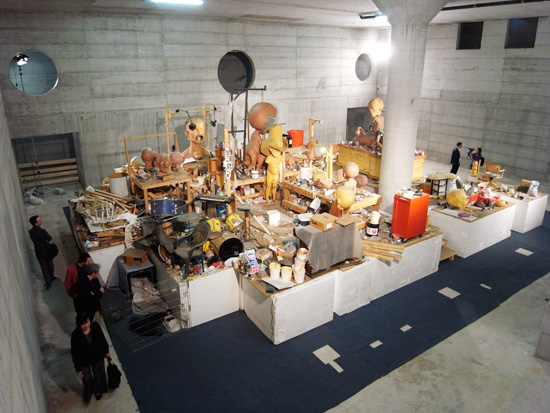
In a third tradition, it is equally norms that are questioned, although not moral ones, but rather norms of a purely artistic nature: changes of style. Also changes of style are often experienced as shocking, as is apparent from the fact that names of styles tend to be terms of abuse (Gothic, Cubism, Fauves.....). Styles have the same effect as religious symbols: they indicate to which group one belongs. And that can make feelings run high. Because it has mostly been great artists who introduced new styles, art was for a third time identified with pushing the boundaries and with shocking transgression.
Good art, hence, has often been transgressive. In expectance, it is important to distinguish between the three forms of transgression.
DOWN WITH THE WARNING FINGER?
For, although Paul McCarthy is apparently very welcome in the temples of art, that is not evident to everybody.
Take Daniël Termont, the mayor of Ghent, who, on occasion of the opening of the show in the SMAK, proudly declared: “Within of the confines of my city, artists are allowed to 'colour outside the lines'. He thereby acknowledges that the mark is overstepped. Nevertheless, in the name of artistic freedom, he will not intervene. And that goes also for Philip Heylen, alderman of culture of the city of Antwerp, who, on occasion of the opening of the show 'Air Born/Air Borne' - in comparison with the show in the SMAK a joke - still had the guts to make a critical note in the name of freedom of speech. For him, 'colouring outside the lines' is allowed, as long as it is permitted to say that it is 'outside the lines. The followers of Pim Fortuyn acted more boldly. they succeeded in referring the six meters high bronze 'Santa Butt Plug' to the courtyard of the Boymans van Beuningen Museum. And the mayor of Angoulême intended to close an exhibition with works of Paul McCarthy.
It is interesting to examine the arguments used in this discussion. The followers of Pim Fortuyn were told that also Ossip Zadkine's statue 'Destroyed City' has been widely contested in 1953, while it is now widely accepted. And that is also the argument with which Philip Heylen called himself to order: have there not been many objections against the purchase of Henry Moore's 'King and Queen' for the Middelheim in 1952'?

Meanwhile, we know that these arguments are not valid. There is a difference between refusing a style and refusing a content: nobody had problems with Ossip Zadkine depicting the despair of a destroyed city. The problem was that he did so in a style that was not generally accepted. In the case of Paul McCarthy, the objection is different: many resent the staging of sadistic orgies in a museum (or the exhibition of a butt plug on a public square). The comparison with Ossip Zadkine would only be valid, when Zadkine had made a statue that glorified the destruction of the city. A valid comparison, on the other hand, would be a comparison with the meanwhile world famous Guillermo Vargas Habacuc, who had the luminous idea of tying a street dog to a wall in the 'Galería Códice' in Managua (2007) and let it starve there from hunger and thirst. That lead to a massive protest from ... animal protectors! Not from the art world, which rather selected the man for the 'Biennale Centroamericana Honduras 2008'. The comparison holds equally for the true to nature wax statues that Maurizio Cattelan hanged on a rope in the trees of a public park in Milan. Since the broadminded authorities let the artist 'colour outside the lines' - Gabriele Albertini, mayor of Milan stressed that 'free expression is the foundation of our society' - an old man tried to remove the sculptures, and fell out of the tree. And the comparison holds equally for the self mutilations of Marina Abramovic in 'Lips of Thomas' (1975), which will be performed in December 2007 in the Guggenheim.*

The protest can be justified on other than moral grounds. Philip Heylen refers to the purchase for some 33.500 Euro of the text 'Iron and gold in the air, dust and smoke on the ground' of Lawrence Weiner for an exhibition of sculptures in the Middelheim in 1997. The man who made a critical note on the moral value of some of Paul McCarthy's sculptures, seems not to come to the idea that letters on a wall cannot possibly be called a 'sculpture', even when the entire art world and Lawrence Weiner himself contend that he is a sculptor. On the ground of this simple fact, the authorities should not have allowed such a 'sculpture' in the Middelheim, which is after all a sculpture park. For the same reason, the galleries of Guillermo Vargas Habacuc should not have allowed him to let a real dog die from real hunger and real thirst in his gallery, and the curators of Guggenheim should not allow Marina Abramovic to really mutilate her real body in their museum. To my knowledge, fakirs and sward swallowers - who, by the way, have style enough to not mutilate themselves - do not belong in the museum, but on the fairground (See: 'Mimesis and art'). These days, it is apparently necessary to remind of the fact that there is a difference between art and displayed reality: Othello only simulates that he is suffocating Desdemona. Someone who does so in the real world is liable to punishment - except when he does it in a gallery, like Guillermo Vargas Habacuc or Marina Abramovic, to enjoy 'artistic freedom'. And that is also why Spencer Tunick pretends to be a 'sculptor'.
Whereas I have no moral objections against the text of Lawrence Weiner or the 'body sculptures' of Spencer Tunick, the objections against creations like those of Guillermo Vargas Habacuc and Marina Abramovic only add up: they have not only a dubious moral status, they are not works of art in the first place.
Not only confusion of norms, hence, but confusion of categories as well.

TRANSGRESSION FOR TRANSGRESSION'S SAKE
In order to understand how such confusion came about, we should have a closer look at the economical aspects of transgression: the effect of the nearly completed integration of art as a ware on the free market.
Also on the art market, every innovation promises extra profits and extra attention.
Let us first have a look at the effects thereof on transgressions of the third kind. We already pointed to the fact that styles can make feelings run high. It suffices to refer to the commotion around Ossip Zadkine's 'Destroyed City'. Here as elsewhere on the developing art market, clever guys - artists as well as art dealers who sell their works and curators who exhibit it - had immediately understood that a change of style can cause a sensation and attract the necessary attention. That is why, from the second half of the nineteenth century onwards, the merry-go-round of the styles began to turn at an ever faster speed. The carrousel of the '(modern)isms' only came to a standstill when 'postmodernism' proclaimed that 'everything is possible', with the effect that it is no longer possible to score with changes of style. Although the storm has subsided, the ravage is inconceivable. Although everything is possible, one solution is better than another. As a matter of fact - and contrary to what the accompanying ideologies want to make us believe - art is in the first place a question of increasing perfection, step by step, and generation after generation. The longer perfection is improved, the higher the quality attained: Mozart's and da Ponte's Don Giovanni is the last shackle in a long chain (See 'Leda and the Swan'). By ever beginning anew from ever new starting points, the level decreases on each new domain. Add to this that not every style is appropriate to every content. It is not evident to praise the beauty of the body when you are a cubist or an adept of geometrical abstraction. That was not much of a problem to someone like Piet Mondrian. But who would in all seriousness maintain that the whole 'comédie humaine' can be reduced to the opposition between vertical and horizontal? We analysed these problems in 'Ligeti's Aventures'.


As far as transgressions of the first kind are concerned - shocking the perpetrators by reminding them of the norm - there are not much problems. To be sure, the propensity to denounce injustice or immoral behaviour, not out of moral indignation, but in view of profit, can now and then lead to the necessary excesses. But there is strong, inbuilt check on the escalation. Who uncovers, should not have something to hide himself. And that is not always obvious. That is why in these matters there is more profit in the construction of appearances, or in making objectionable conduct acceptable: think of the nowadays so popular demonising of opponents in order to get rid of the norm unpunished. It is precisely to such construction of appearances that we owe an important part of 'culture industry' that cries for being unmasked.
The second kind of transgression on the other hand - the questioning of the norm - offers endless perspectives. Wares are the natural allies, not so much of utility, than rather of the drives. It matters to conquer new markets. Norms differ from culture to culture, and they are often adjusted during the course of time. Above, we described how the severe sexual moral of Christendom came to be questioned in ever broader layers of the population. In every phase of the process during which the flesh was restored, the artists in question could reckon not only on the indignation of those who wanted to maintain the status quo, but above all on the interest of all those who were out at undisturbed erotic pleasure. As the flesh became restored, the possibilities for shocking and attracting the attention were increasingly reduced. But, that is not much of a problem for clever guys. In the dungeons of oppression, many drives are awaiting their liberation. Why not release ever new drives from their chains? The sexuality that came to be freed, turned out to be heterosexually restricted. There remained a struggle to be fought for the homosexual variant. And when this victory was won, the possibility remained to extend the kinds of intercourse and the age of the partners. At the same time, the sadomasochistic universe could be disclosed. The interesting thing here is that the resistance only increases when the drives are released from deeper dungeons: all the greater is the sensation and all the greater the attention attracted.
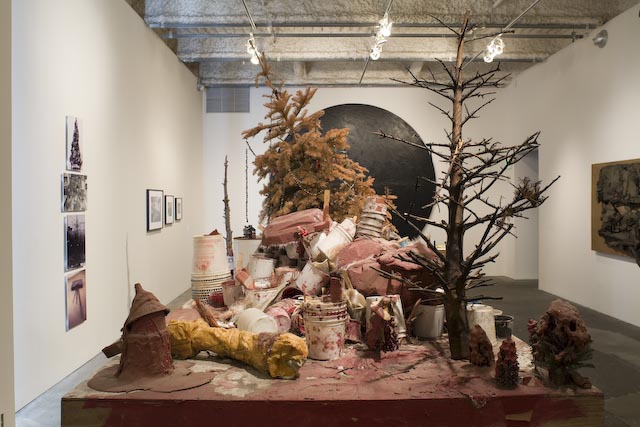
Sooner or later a boundary is breached. In the limit, the norm itself is questioned. But that cannot but provoke the reaction of those who are thereby harmed. For, cheating is nice, being cheated less. That is why honesty - or faithfulness - is a norm. Or, to bring things to a head: some two thousand years ago, nobody objected when muscled, naked man fought each other with pointed tridents and sharp swards. We owe it to Jesus that such things are no longer permitted today: he tried to teach us that we should love our neighbours like ourselves. That is why our Western democracies are supposed to protect the rights of the entire herd, otherwise than their Greek model, where the 'Masters' judged that other men could be subordinated like 'Slaves' for the satisfaction of their needs and drives. Shall we also question this norm in the name of the emancipation of the drives?
There is no point in promoting the questioning of the norm to the norm, to the new convention, yes even to a holy duty, as the smart guys would have it, who have proclaimed the artist as the transgressor par excellence, and can thereby reckon on the sympathy of all those who find some norm on their way. It only matters to mitigate all too severe norms, to reconsider wrong norms, and to introduce new norms if necessary. We have to be consequent then, and clearly speak out that artistic freedom cannot be unrestricted in matters of morality. Just like the freedom of speech does not include the right to deliberately spread lies, artistic freedom does not include the right to praise patently immoral conduct. Meanwhile, it is only waiting for the moment when the glorification of the rape of babies will reach the galleries and the museum - merely as mimesis on the two-dimensional canvas, or three-dimensional and animated with the 'animatronicst with which Paul McCarthy makes Bush f.ck a pig, if not live like the performances of Marina Abramovic or the installations of Guillermo Vargas Habacuc.
It suffices to overlook the evolution of Paul McCarthy's work to assess how he has succumbed to the escalation of transgression, to eventually end up in what many - with the obligate reference to a great work of art - describe as 'the hell of Dante'.
In this context, it is not superfluous to remark that in Dante's Inferno, those who 'coloured outside the lines' - the 'sinners' in a somewhat antiquated terminology - are not served, but punished. This is a remarkable 'Fehlleistung' (slip of the tongue): when indulging in what is apparently a 'sin', there is no waiting long for the warning finger - or to call also that thing by its name: conscience.

PUSHING THE BOUNDARIES : FROM THE TWILIGHT INTO OPEN DAYLIGHT
Smart guys who shy away for the last windings of the downward spiral to hell, dispose in expectance of a whole array of other possibilities.
A first possibility consists in upgrading the ware: what previously could only thrive in the twilight of the book, the print, the photo or the video, can always be brought into the spotlights. When Courbet painted his 'L'origine du monde' in 1866, it was already possible to peep between the legs on photographs. On a painting, it was perhaps something new. The owner nevertheless hided the painting behind curtains. Today, it is openly on view in the museum, without curtains, and the wait is only for a curator who wants to score in the media hangs it in front of the Mona Lisa in the Louvre. The story can be repeated again and again. Homosexual pleasures went under the counter as soon as photography was invented, but it is only with Robert Mapplethorpe that they were allowed in public in the galleries. And that goes also for the - compared with what there is to be seen in the darkest regions of the art industry - rather modest sadism that has been veiled so artsy by Joel-Peter Witkin, that it could pay its respects in the public art circuit - albeit in the sector photography.
Paul McCarthy resorts not only to obligatory transgression, but also to increasing publicity. On a modest screen somewhere in the basement of the museum, his creations would already have been shocking enough. But by projecting his sadistic orgies on all the walls of an entire museum, or by casting his 'Santa Butt Plug' six meters high in bronze and inflating it on a much larger scale in a sculpture park, Paul McCarthy claims the largest possible publicity. That speaks volumes, not only about the large size that is totally superfluous from a contentual point of view, but especially about the 'parody', that shows thereby its true face: there is nothing in creations of Paul McCarthy that betrays that they are meant to be critical. The large size inflated 'Butt Plug' could as well serve as a logo for the factory that produces such playthings, or welcome the visitors at the entrance of an erotica fair. That it is meant as a parody can only be derived from the fact that it is presented in a sculpture park. We need not rely on the context to know that Ravel's 'La Valse' is a parody: the music speaks for itself, regardless of the context.


Also here it applies that what may be tolerated in private or behind closed doors - and that will be necessary and desirable in every culture - must not necessarily be tolerated in public, let alone in institutions that are supposed to hold up standards. For the same reason, deliberate lies may perhaps be tolerated in everyday life, but not on prime time on television, let alone before a plenary session of the UN.
FROM SHOWING TO CONDEMN, TO SHOWING AS SUCH
A next way out is far more difficult to unmask: the use of an alibi for staging what is morally objectionable. In that respect, we have a rich tradition in the Western world. It is well known how the nude body of Christ and Sebastian, or of Greek gods and goddesses, knew to enrapture many a man or woman. Even more voluptuous was the deployment of the sado-masochistic universe in Christian art: not so much battles, as rather the graphic depiction of the suffering of martyrs, not to mention the punishments in hell, were a most welcome alibi.
The best alibi, however, is the moral alibi itself. The morally objectionable is shown, not to praise it, but to condemn it. That is in the first place the case with all the minor human vices in the twilight zone between the permissible and impermissible: think of the unfaithfulness of Don Giovanni, who is eventually driven in hell, or of 'Cosi Fan Tutte', where the unfaithful eventually ask for forgiveness. But it can be extended without problems to the darkest corners of the moral universe: the more graphic the depiction of vice, the greater the moral indignation.
Everything depends on the way in which the morally objectionable is depicted. The way in which Mozart has composed his don Giovanni cannot but betray the warm sympathy he felt for the hero of unfaithfulness. But that goes even more for the unforgettable music with which the Commendatore drives the scoundrel to hell: one of the greatest pages in the history of music.
Soon, the formula as handled by Da Ponte and Mozart, was experienced as 'hypocrite' by all those who identified with Don Giovanni. Whereupon the Commendatore was simply fired.
With such music in my ears, my fingers refuse to type the name of 'P..l McC.rth.' With him, the formula is totally perverted. On Picasso's Guernica, you will search in vain for a detail that could turn on a sadist. But Paul McCarthy depicts what he pretends to criticise so graphically, that he nearly suffocates from wallowing. Nobody will point his finger at him, because he does so already himself, and he knows to sell his wallowing as a 'grotesque'. And, just like the torturers of the Inquisition could let themselves pass for the keepers of virtue, he can inscribe himself in the respectable tradition of critical art. If the rapists of babies ever want to conquer the museums, they certainly have to learn something here.
THERE IS MORE TO ART THAN JUST PAINTING
There is still another way out for those who find it too difficult to renew art form a contentual or formal point of view: they can always transgress the boundaries of art itself: and try to let design, displayed reality and (preferably non-verbal) statements pass for art (see 'Mimesis and art').
To succeed, it is crucial to deny that a border is crossed here that simply should not be crossed: the boundaries of art itself. Nobody goes to the Olympics to get a strip-tease served.
It may be surprising, but in matters of art, there is no problem in letting a strip-tease pass for a football match. A host of often brilliant philosophers must meanwhile haven written an entire library to get the trick done. The arguments can be reduced to two. In a first line of reasoning, art is understood as a historical given in the vain of 'In the beginning, art was nearly discernable from magic, mythology and religion. Why should it not continue to take new forms?' In a second train of thoughts, we are triumphantly reminded of the fact that the question 'Is this still art?', has always been caught up by the general acceptance of the objected art works: just think of Marcel Duchamp's 'Fontaine', that has been proclaimed 'the art work of the century'. Needless (?) to remind of the fact that 'Fontaine' is nevertheless not a work of art, and will never be one. After we got served slides in the Tate Modern, and even dying dogs appear on the menu, should it not begin to dawn on us?
Especially displayed reality has - apart from the fact that is more easy to pick a flower than to paint one - its secrets charms. Although the merely imitated world of art can surpass the real world in every respect, the real thing is, notwithstanding its limitations, always more alluring. Already Hume - who therewith draws the proper line between art and non-art - remarked that people immediately leave the 'blood and slaughter' in the theatre when there is a real execution on the market place. That is why a simulated auto mutilation - like that of Paul McCarthy who chops only polyester legs - will never be a match for the 'real thing' of Marina Abramovic. For the same reason, the adepts get a greater kick from the photographed - indexical - mutilation of real bodies by Joel-Peter Witkin - albeit corpses - than from the merely painted mutilations of Grünewald...

Paul McCarthy, Mutant, 1994, Collection of the Vancouver Art Gallery, Vancouver.
THE QUEST FOR PERFECTION,,,,,
There can no doubt that 'art' - the word speaks for itself - has something to do with quality. Just like we go to the Olympics to admire exceptional performances, just so a museum ought to be a place where works of a more than normal quality are exhibited. If art has something to do with 'pushing the boundaries', then it is certainly standards of quality that should be pushed - ever higher.
We already mentioned the poor artistic quality of Paul McCarthy's work. Just sacrifice some minutes of your precious life to have a look at 'The Painter' (the lowest screen). You probably will be shocked, not only by the pathetic approach of the otherwise already dubious theme, but also by the bluntly ridiculous acting of Paul McCarthy, not to mention the, if possible, still more ridiculous quality of the film as such. I will bet you anything that you have been messing about with that lever to get things moving faster, question of not falling asleep underway, or in the expectance that something might still happen. Perhaps you now understand better what I meant with the trick of the simultaneous projection of 'highlights' on those giant screens in the SMAK.

Paul McCarthy, Bunkhouse, 1996, Courtesy Phillips de Pury & Company.
Do we really have to welcome the maker of such masterpieces as a misunderstood genius? To phrase it otherwise: can you imagine Shakespeare delivering such stuff to his public in The Globe? Which makes it clear at once what of kind of orgy is celebrated here really: that of the rancour of the ever increasing horde of the impotent and ignorant, who cannot but resign when faced with the ever increasing heights the masters of the past knew to achieve. The rancour against beauty - for, in matters of art, beauty is the name of formal and contentual quality. A cleverer guy like Marcel Duchamp had soon understood that he was not a match for Picasso in Paris nor for Kandinsky and Munich, and preferred to perform the trick with the bicycle wheel in New York, hors concours. Of a lower sort is the rancour of Paul McCarthy, who assaults a lower god like Willem de Kooning, to drag him with more pedestrian means - with his tail between his legs - through the mayonnaise and the ketchup. Granted: with Van Eyck, Brueghel, Rubens, Goya, yes even with Picasso in the role of Willem de Kooning, it would have become all too obvious how dreary this performance is! And make it clear what drama of culture is phrased in that seemingly banal quotation from Paul McCarthy: 'There is an old feud boiling, painters versus conceptual artists. The doctrine of painting and beauty versus the doctrine of Michael Asher' (For those who do not know the name of this other misunderstood genius: Michael Asher is a Californian prophet of conceptualism).
All this makes it clear at once what boundaries have not been pushed for decades: those of artistic quality. In the recent past, they have rather been 'deconstructed' professionally, so that we have ended up, not in the realm of immorality this time, but in that of generalised impotence and ignorance - if not in both together.
Ignorance that wants to pass for mastery, succeeds in doing so, and in the end becomes the norm: is this not shocking par excellence?

Paul McCarthy, Butt-Plug, Multiple.

Paul McCarthy, Grand Pop 1977, Los Angeles California, 1977, 1995 {printed}, © Paul McCarthy.
ON THE INQUISITION, FASCISM AND NEO-LIBERALS
After this analysis, we understand how misleading it is to proclaim after every transgression the artists and their curators to heroes, and to remind all those who feel shocked of Savonarola, the Inquisition, the 'Salon de Refusés' and the 'Entartete Kunst'. Although all the authorities in question may have had their own reasons to feel shocked, in terms of the criteria laid out above, they had not a leg to stand on. Rather is it we who are entitled to feel shocked by the hypocrisy and the lack of quality they wanted to present us as great art.
Nevertheless, the reference tot the Inquisition and the Nazis continues to be remarkably popular. As a warning finger, it suffices to silence every opposition - who wants to pass for a philistine? Certainly not the authorities. Let us quote Philip Heylen: 'Many would have liked me to close a part of the show, so that they would be able to denounce the politician as an exponent of the establishment'. Or Arthur Vlaardingerbroek of Rotterdam who, on occasion of the affair around 'Santa But Plug' in Rotterdam let slip the remark: 'When a politician wants to intervene with the content of art, he cannot fail to be scorned as a Nazi’. The heroic mayors above have also examples of a higher, ministerial rank. Think of the former French minister of culture - Renaud Donnedieu de Vabres from the not precisely progressive UMP. After the performance of Jan Fabre's 'L'histoire des larmes' - yet another hero of transgression who practices culture criticism with body fluids, and does equally not refrain from smearing ketchup and chocolate sauce - nipped the protest in the bud by applauding demonstratively. Not only politicians have learned their lesson. Also the commentators in the press really do their best to not appear as narrow-minded moral crusaders. With slogans seldom to be heard even in the world of advertising, art educators like Amarant lure the herd in the temple to be professionally initiated. Talking about education: the keepers of transgression will not rest before all layers of the population - children included - are converted to the true faith: curator Philippe Van Cauteren - who esteems that a visit of Plopsaland ( a loal version of Disneyland) is more dangerous than a visit to his show, and does not come to the conclusion it had better be closed - provides entire educational packages for schools, and the pupils cannot be young enough to be initiated in the cult. Even of the formerly so scorned 'worried parents' there is no longer any trace. Nowadays it seems rather bon ton to manoeuvre the youngest, even before they can walk, in buggies through the 'inferno', as I could witness with my own eyes.

Paul McCarthy, Bossy Burger, 1991, Courtesy Hauser & Wirth.
It pays to have a closer examination of the obligate reference to the Inquisition and the Nazis. Inquisitors and dictators are the personification of everything people loathe in political and religious authorities: the so scorned 'warning finger' - or, if necessary: the torture chambers and concentration camps - of church and state alike. Granted, we had not much to complain during the last decennia - at least not in the Western World. Although the return of the fellows is far from improbable, one cannot escape the impression that they are all too readily invoked as a spectre. Could it be that the widespread antipathy for the 'warning finger' - and the even more widespread cult of the heroes of transgression - have something to do with all those minor and major devils that many so dearly would like to cherish on their bosom, although they do not tolerate daylight? The problem with the abuse of these spectres is that it only obfuscates the fact that the power of state or churches dwindles in comparison with the power of the 'Invisible Hand' of the market, which, in matters of art - in the museum not otherwise than in the porn industry - increasingly imposes the dictate of the obligate transgression, and therewith lures all these minor and major devils out of their holes. The enlightened spirits that would have us march in the ranks of the permanent and obligate transgression, have only exchanged one master for another. Instead of shrinking under the reproving gaze of the Great Inquisitor or the Führer, they rather submit to the dictate of the Free Market and its ware like slobbering dogs. They are the neo-liberals of the art market, who dismiss as 'Fascism' or 'Inquisition' every intervention of man in the invisible, blind mechanisms of which he threatens to become the victim. They want a 'strong state' only to warrant 'artistic freedom', so that the market has free rein. The warning finger may be raised, if not against the ware, but against those who question its supply. The state is allowed to pay, to organise, to subsidise, but not to intervene: that is the privilege of the curators in the conclave.
From the above, it appears sufficiently that I am therefore not an advocate of democratic participation in the conclave: there is no democratic vote about quality. Even less do I plead for an intervention of the political or religious authorities. Quite the contrary: precisely because they are authorities, they have much to defend and even more to hide, and has there to be safeguarded, just like for freedom of speech, a free zone for art, at all cost. But, even more than for political and religious authorities, I am afraid of the invisible authority of the free market: it has much to sell, and hence even more to justify and to obfuscate. That is precisely why it succeeded, not so much a turning art into its very opposite, as rather debasing it into its lowest forms.

It is time to break the stranglehold in which the 'Invisible Hand' threatens to suffocate art. Just like real love, good art is not a ware, but a gift, for which you can only be grateful. For, as opposed to love, which can be reciprocated, this giving can not be answered by giving in turn. Gratefulness and admiration must suffice. Although also this norm has to be handled with the necessary suppleness. After all, also the artist must earn his living. But it must be clear that it is the norm. Since time immemorial, paid love has been called whoredom. It is about time to find a name for paid art.
Two thousand years later, it is time, hence, to chase the merchants from the temple again: they have wreaked too much havoc there during the last century. To do so, we should better not rely on the authorities, question of not falling in the hands of Pharisians. Ever since the Enlightenment, we have a better weapon than Jesus' whip: free speech. It matters to lift the veils behind which the free market hides: in case the fable of the elusive nature of art and the whole rhetoric of transgression (the special variant of modernism included); It is about time that the progressives among us - or simply all those who care about the fate of art - denounce the 'emancipatory' rhetoric that the market has recuperated for its own purposes.
As we succeed in that task, the way will be paved for the long awaited innovations of the image that we so badly need...
Stefan Beyst, November 2007

















